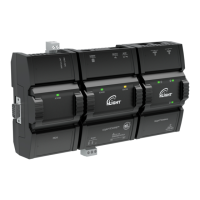CHAPTER 15
ECLYPSE Controller Troubleshooting
You can use this Troubleshooting Guide to help detect and correct issues with ECLYPSE controllers.
Symptom Possible Cause Solution
Controller is powered but
does not turn on
Fuse has blown (for 24V
controllers)
Disconnect the power. Check the fuse integrity. Reconnect the power.
Power supply polarity
Verify that consistent polarity is maintained between all controllers and the transformer.
Ensure that the COM terminal of each controller is connected to the same terminal on the
secondary side of the transformer.
See
DHCP Versus Manual Network Settings.
The device does not have
power / poor-quality power
(for 24V controllers)
Verify that the transformer used is powerful enough to supply all controllers. See
Transformer Selection and Determining the Maximum Power Run Length.
Device does not
communicate on the BACnet
MS/TP network
Absent or incorrect supply
voltage (for 24V controllers)
1. Check power supply voltage between 24VAC/DC and 24V COM pins and ensure that it is
within acceptable limits (±15% for 24V controllers).
2. Check for tripped fuse or circuit breaker.
Overloaded power
transformer (for 24V
controllers)
Verify that the transformer used is powerful enough to supply all controllers. See
Transformer Selection and Determining the Maximum Power Run Length.
Network not wired properly Double check that the wire connections are correct.
Absent or incorrect network
termination
Check the network termination(s).
Max Master parameter
Configure the
Max Master
to the highest MAC Address of any device on the MS/TP data
bus. See Setting the Max Master and Max Info Frames.
There is another controller
with the same MAC
Address on the BACnet
MS/TP data bus
Each controller on a BACnet MS/TP data bus must have a unique MAC Address. Look at
the MAC Address DIP switch on each controller. If it is set to 0 (all off), check the MAC
Address.
There is another controller
with the same Device ID on
the BACnet intranetwork
Each controller on a BACnet intranetwork (the entire BACnet BAS network) must have a
unique Device ID. See Adopting a Numbering System for MAC Addresses, Device Instance
Numbers, and Network Numbers.
BACnet data bus polarity is
reversed.
Ensure the polarity of the BACnet data bus is always the same on all devices. See BACnet
MS/TP Data Bus is Polarity Sensitive.
Cut or broken wire. Isolate the location of the break and pull a new cable.
The BACnet data bus has
one or more devices with
the same MAC Address.
See Adopting a Numbering System for MAC Addresses, Device Instance Numbers, and
Network Numbers.
The baud rate for all
devices are set to AUTO
At least one device must be set to a baud rate, usually the data bus master. See Baud Rate.
The device is set to a MAC
Address in the range of 128
to 255.
See if the STATUS LED on the device is showing a fault condition. See the LED Fault
Conditions provided by the manufacturer of your BACnet controller.
This range is for slave devices that cannot initiate communication.
The maximum number of
devices on a data bus
segment has been
exceeded.
Use a repeater to extend the BACnet data bus. See Maximum Number of BACnet MS/TP
Devices on a Data Bus Segment and Baud Rate.
The STATUS LED is blinking
The device has auto-
diagnosed a fault condition
See the LED Fault Conditions provided by the manufacturer of your BACnet controller.
Controller communicates
well over a short network
BACnet MS/TP network, but
does not communicate on
large network
Network length See Data Bus Physical Specifications and Cable Requirements.
Wire type See Data Bus Physical Specifications and Cable Requirements.
Network wiring problem Double check that the wire connections are correct.
Absent or incorrect network
termination
Check the network termination(s). Incorrect or broken termination(s) will make the
communication integrity dependent upon a controller's position on the network.
ECLYPSE Controller Troubleshooting
116
nLight ECLYPSE

